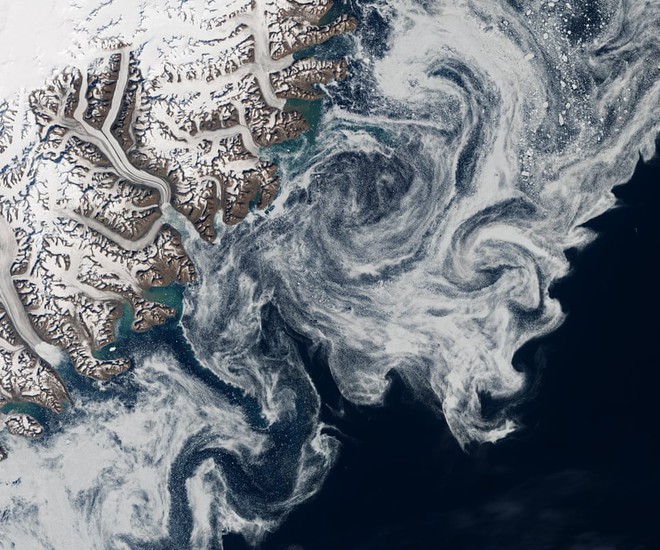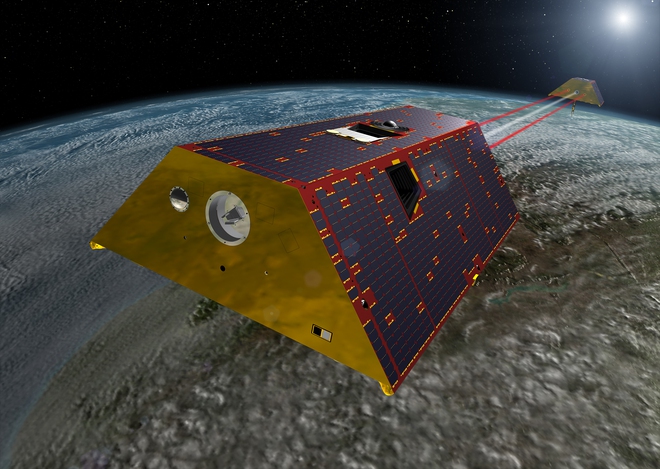Within 2019, the Greenland ice melts at a rate of 1 million tons / minute
- Tram Ho
We have just noticed disturbing signals in observed data from satellites: Throughout 2019, Greenland lost a huge amount of ice, equivalent to a speed of 1 million tons / min. The climate change crisis has made the South of the Arctic region hot up rapidly, the ice is melting and will cause inevitable consequences of sea level rise.
Last year, the Arctic ice sheet lost about 532 billion tons, as surface ice melted and glaciers broke into pieces that fell into the water; per second, the amount of water “broken” out of the ice here is enough to fill 7 swimming pools with a volume of 2.5 million liters / tank. The satellite has been collecting data since 2003, and analyzes show that the amount of ice lost in 2019 is twice the annual melting of 255 billion tons. A huge portion of the ice loss last year melted in July 2019.

Sea of ice in the Danish Strait on the east coast of Greenland.
Scientists know well that the rate at which ice has melted in recent decades has been much faster, but the new data is more accurate than before, before taking into account the amount of new snow falling, the calculation for the actual loss of ice is more correct. before. Researchers were stunned by the great loss, saying that this is most likely the biggest ice-melting event in decades, even millennia.
If the entire Greenland ice sheet melted, the sea level would rise by 6 meters. However, the team says it’s still unclear whether the ice sheet has actually hit the “irreversible” mark, and reducing emissions will slow the thawing process, which will last for centuries. enormous amount of ice.
Extreme weather events that have kept a large amount of hot air in Greenland are the reason why the ice melts so quickly. And when the Earth is warming up, the above phenomenon will continue to take place strongly. Nearly 96% of the ice sheet exhibited melting in 2019, compared with the 64% average for the 1981-2010 period.
“ Looking at the numbers, 2019 is really bad. But they are not very surprising, because we have seen two strong thaw in 2010 and 2012, and I think we will see many more like this, ”said Ingo Sasgen of Alfred Wegener Institute, Germany, who leads research on analyzing satellite data, said.

Helheim Glacier June 2018.
Due to extreme weather phenomena, the amount of snowfall in 2019 in the Greenland area decreased significantly, causing less new ice to form, not enough to compensate for the rapidly melting ice. The consequences don’t just stop there: flowing water will make the ice sheet weaker and more fragile; The hot weather melts the ice, revealing dark patches of ice that absorb a lot of heat.
The ice will continue to thaw while the temperature in the Arctic region is still rising, so it’s very important to observe closely how the ice in this area changes. Researcher Ingo Sasgen and colleagues are on the right track by constantly keeping an eye on the Arctic ice. Their new research is published in the journal Nature using data from NASA’s Grace satellite; Grace measured the Greenland ice’s mass with gravity tools.

NASA’s Grace satellite.
The first Grace satellite ended its data collection mission in June 2017. Data from the second satellite was used to find out how much ice was lost between two times. Researchers found that the amount of ice loss in 2017 and 2018 was particularly low, due to the effects of the aforementioned extreme weather phenomena, but between 2017-2018, only cold air was trapped in the arctic region. However, thawing of the ice meant that cold times did not make up for hot years.
Prof Stefan Rahmstorf from Potsdam University said that the new figures are very convincing, and the transition period between the old and new satellite has been smooth. He added that the melted water from the ice was entirely fresh water, blurring the waters around the ice sheet several times.
Mr. Rahmstorf took the 52,500-ton cargo ship as an example: “ If we want to turn 500 billion tons of melted freshwater in 2019 into seawater, we will have to use up to 200,000 Panamax class cargo ships filled with salt. poured into the Atlantic “.
Even though it thawed quickly, the fate of the Greenland ice sheet has yet to be determined. First, when glaciers melt and retreat inland, they no longer touch the warm water and, therefore, dissolve more slowly. Second, the melting of the ice from the warm air is very slow, taking several centuries to melt the entire ice sheet, while at the same time we have been able to keep the global average temperature from getting too high.
” If we reduce CO2 emissions, we will reduce the melting of the Arctic ice and slow sea level rise due to the melting of the Greenland ice ,” said researcher Sasgen. ” So while the ice will largely disappear, it will be slow, it will take time for 600 million people living near the coast to move .”
Consult the Guardian
Source : Genk
